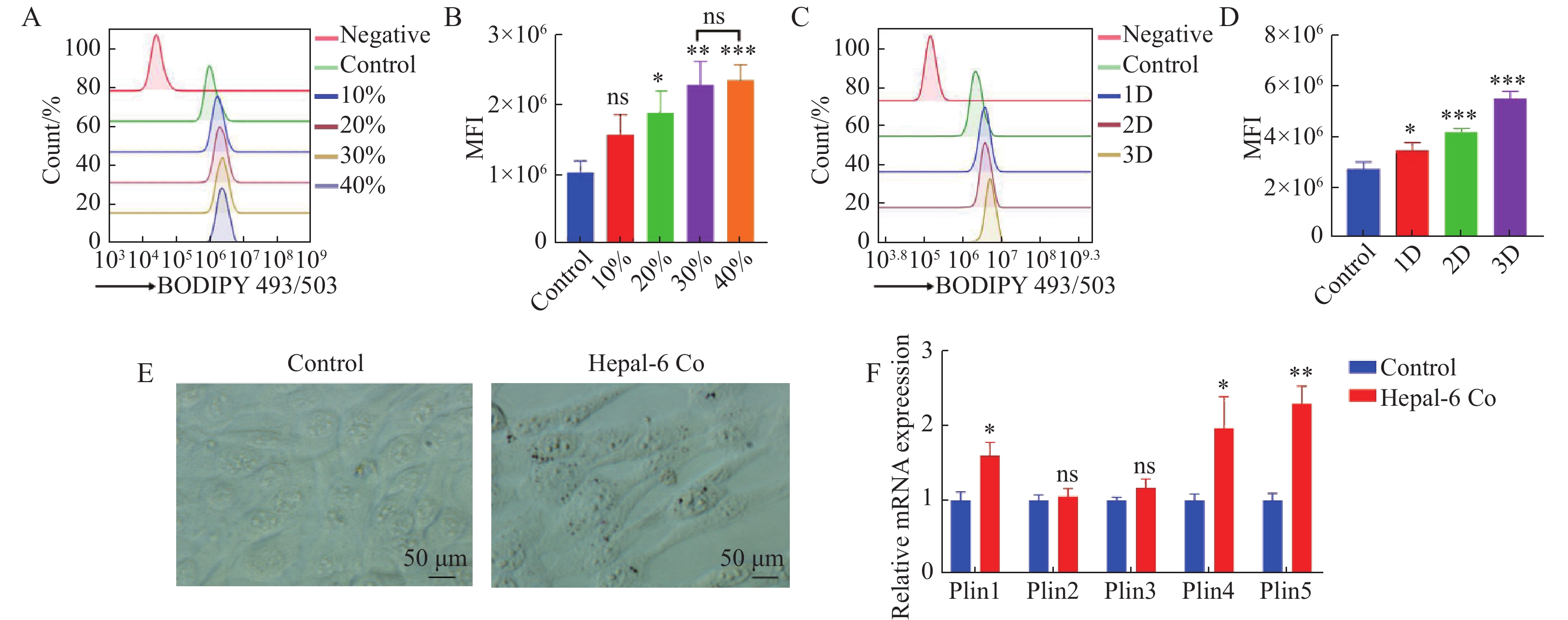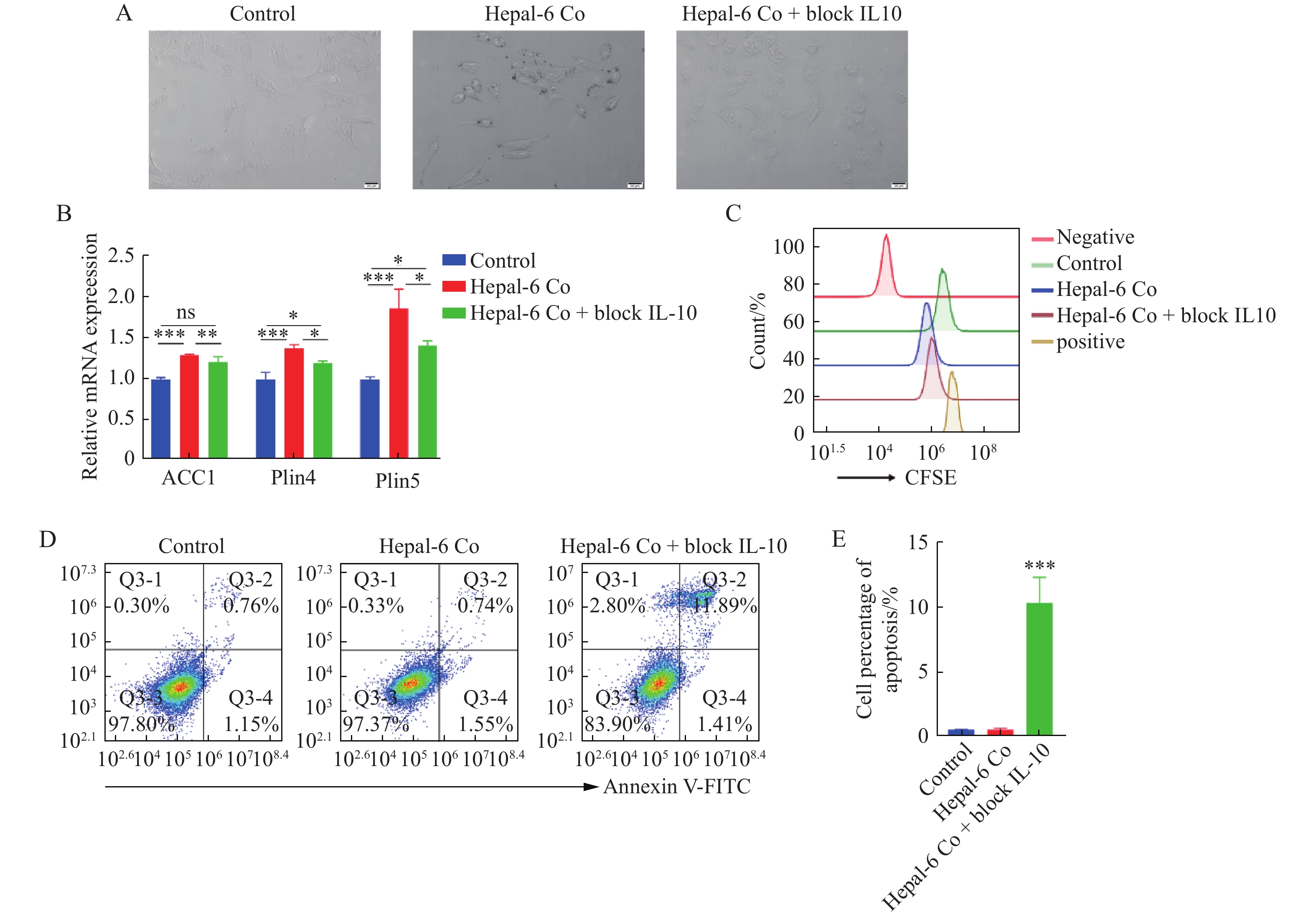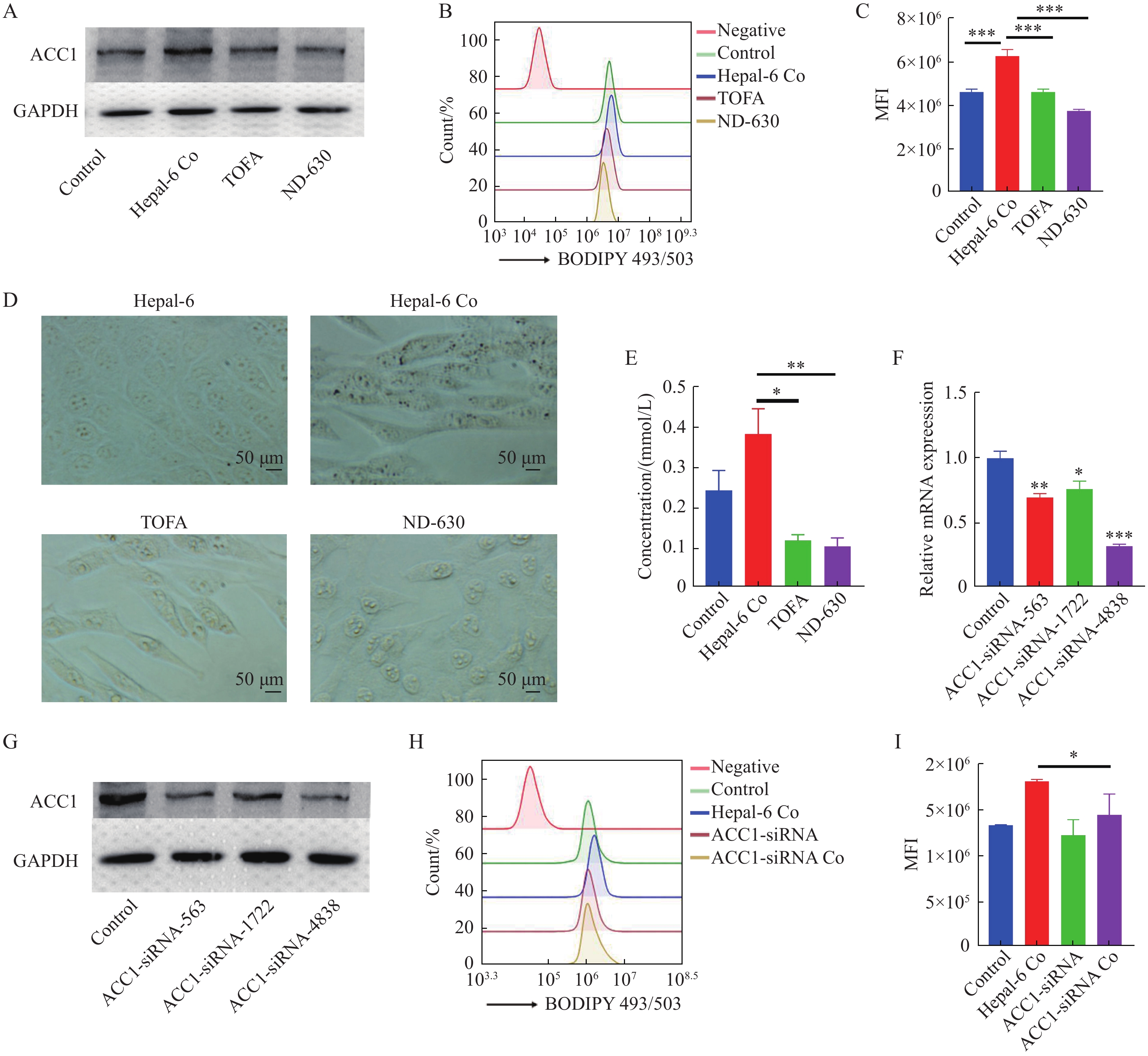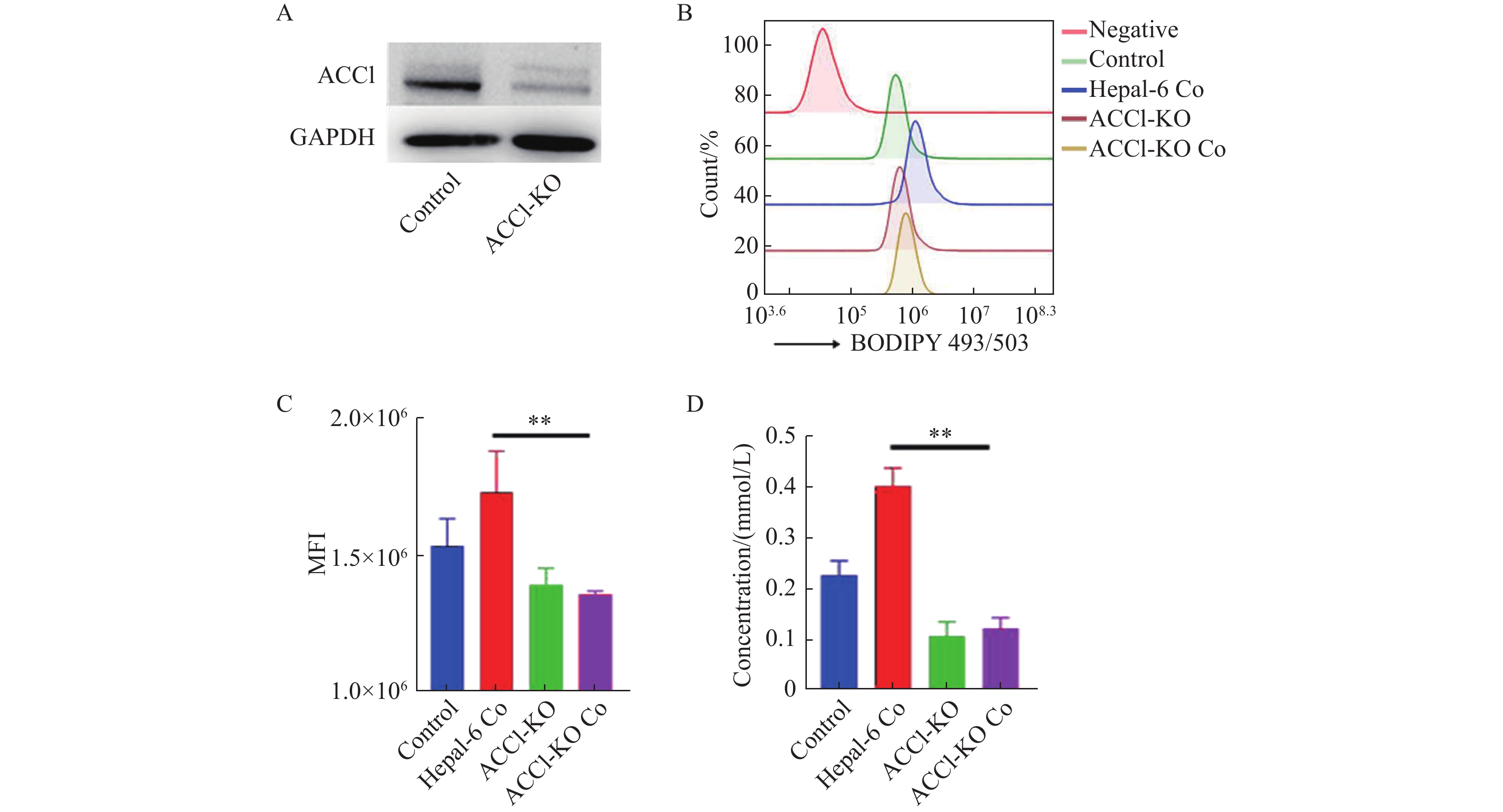Effect and mechanism of acetyl-CoA carboxylase 1 in regulating the proliferation of hepatocellular carcinoma cells
-
摘要:
为了探究巨噬细胞如何促进肝癌细胞的脂滴囤积,并深入研究脂滴的关键代谢酶在肝癌细胞恶性生物学中的作用,利用肿瘤相关巨噬细胞(tumor-associated macrophages, TAMs)上清液诱导Hepa1-6脂滴(lipid droplets, LDs)生成,发现TAMs中的白细胞介素10(interleukin-10, IL-10)能够促进脂滴的积累。乙酰辅酶 A 羧化酶(acetyl-CoA carboxylase alpha, ACC1)是脂肪酸合成的关键酶之一,影响着肝癌的发生发展。本研究发现,ACC1在LDhigh Hepa1-6中高表达,之后通过ACC1的小分子抑制剂、siRNA干扰和CRISPR-cas9敲除等手段阻断ACC1的活性,发现Hepa1-6脂滴积累降低,同时减少了Hepa1-6增殖的恶性生物学行为,促进了Hepa1-6发生凋亡事件。综上所述,TAMs释放的IL-10促进了肝癌细胞的脂滴形成,导致肝癌细胞的恶性增殖与凋亡。ACC1在TAMs促进肝癌细胞脂滴积累过程中发挥关键作用,并且可能受TAMs释放的IL-10的调控,这些发现可为肝癌治疗提供新的靶点。
Abstract:In order to investigate how macrophages promote lipid droplet hoarding in hepatocellular carcinoma cells and to delve into the roles of key metabolic enzymes of lipid droplets in the malignant biology of hepatocellular carcinoma cells, the present study was conducted to induce the generation of Hepa1-6 lipid droplets (LDs) using supernatants from tumor-associated macrophages (TAMs), and found that interleukin-10 (IL-10) in TAMs was found to promote the accumulation of lipid droplets. Acetyl-CoA carboxylase alpha (ACC1) is one of the key enzymes for fatty acid synthesis and influences the development of hepatocellular carcinoma. In this study, ACC1 was found to be highly expressed in LDhigh Hepa1-6, and subsequent blockade of ACC1 activity by means of a small molecule inhibitor of ACC1, siRNA interference, and CRISPR-cas9 knockdown was found to reduce the accumulation of Hepa1-6 lipid droplets, as well as to reduce the malignant biological behavior of Hepa1-6 proliferation, and to promote the occurrence of apoptotic events. In summary, IL-10 released by TAMs promoted lipid droplet formation in hepatocellular carcinoma cells, leading to malignant proliferation and apoptosis of hepatocellular carcinoma cells. ACC1 plays a key role in the promotion of lipid droplet accumulation in hepatocellular carcinoma cells by TAMs and may be regulated by IL-10 released by TAMs, and these findings may provide a new target for hepatocellular carcinoma treatment.
-
-
Figure 1. tumor-associated macrophage (TAMs) model establishment
A: q-PCR for CD206, ARG1, VEGFα, IL-10, inducible nitric oxide synthase (iNOS), interleukin-12 subunit alpha (IL12A), TNFα mRNA expression levels; B: flow cytometry was used to detect the expression of PD-L1 in TAMs*P < 0. 05,**P < 0. 01,***P < 0. 001
Figure 2. LDhigh Hepa1-6 cell model constructs and TAMs infiltration induced accumulation of LDs in hepatocellular carcinoma cells
A and B: Hepa1-6 was stimulated with different concentrations of TAMs supernatants (10%, 20%, 30%, 40%), stained with BODIPY 493/503, and LDs accumulation in Hepa1-6 was detected by flow cytometry; C and D: 30% TAMs supernatants were stimulated for 1, 2 and 3 days, stained with BODIPY 493/503 and flow cytometry was used to detect the accumulation of LDs in Hepa1-6; E: Oil Red O labelled LDs; F: q-PCR for Plin 1, Plin 2, Plin 3, Plin 4, Plin5 mRNA expression levels*P < 0. 05, **P < 0. 01,***P < 0. 001 vs control group
Figure 3. IL-10 secretion by TAMs induces accumulation of LDs in hepatocellular carcinoma cells A: q-PCR for IL-10, TGFβ, IL-12, TNFα mRNA expression levels; B and C: Stimulation with different concentrations of IL-10, BODIPY 493/503 staining, and flow cytometric detection of LDs accumulation in Hepa1-6, MFI: Mean fluorescence intensity
*P < 0. 05,**P < 0. 01,***P < 0. 001
Figure 4. IL-10 deletion affects lipid droplet formation, cell proliferation and apoptosis
A: Oil Red O labelled LDs; B: q-PCR for ACC1, Plin4, Plin5 mRNA expression levels; C: CFSE staining labelling to detect the effect of IL-10 deletion on the proliferation of Hepa1-6 cells; D and E: Effects of IL-10 deletion on apoptosis in Hepa1-6 cells*P < 0. 05 ,**P < 0. 01, ***P < 0. 001 vs control group
Figure 5. High expression of ACC1 in LDhigh Hepa1-6 cells and implications for cancer
A: q-PCR for ACC1, FASN, ACSL, DGAT1, DGAT2 mRNA expression levels; B: Western blotting for ACC1 protein levels; C: ACC1 expression levels in clinical samples of hepatocellular carcinoma compared with normal tissues; D: ACC1 expression levels in different hepatocellular carcinoma stages (stage1, stage2, stage3, stage4); E: ACC1 expression levels in different hepatocellular carcinoma grades (grade1, grade2, grade3, grade4); F: Survival curves of patients with ACC1 high expression and F: Survival curves of patients with high ACC1 expression and low ACC1 expression; G: Survival curves of patients with high ACC1 expression and low ACC1 expression in different liver cancer grades (grade1, grade2, grade3, grade4) (*P < 0. 05,**P < 0. 01,***P < 0. 001)
Figure 6. ACC1 mediates the accumulation of LDs in LDhigh Hepa1-6 cells
A: Western blotting to detect ACC1 protein level; B and C: BODIPY 493/503 staining and flow cytometry to detect the accumulation of LDs in TOFA and ND-630-treated Hepa1-6 cells, MFI: Mean fluorescence intensity; D: Oil Red O labelling of LDs; E: TG content of the cells; F: q-PCR to detect the expression level of ACC1 mRNA and assess the effect of ACC1-siRNA interference; G: Western blotting to detect ACC1 expression level and assess the effect of ACC1-siRNA interference; H and I: BODIPY 493/503 staining and flow cytometry to detect the effect of siRNA interference on the accumulation of LDs in Hepa1-6, MFI: Mean fluorescence intensity (*P < 0. 05,**P < 0. 01,***P < 0. 001 vs control group)
Figure 7. ACC1 knockdown inhibits the accumulation of LDs in LDhigh Hepa1-6 cells
A: Western blotting to detect the expression level of ACC1 and evaluate the effect of ACC1 knockdown; B and C: BODIPY 493/503 staining and flow cytometry to detect the effect of ACC1 knockdown on the accumulation of LDs in Hepa1-6; D: triglyceride (TG) content of the cells, MFI: Mean fluorescence intensity*P < 0. 05,**P < 0. 01,***P < 0. 001
Figure 8. ACC1 affects Hepa1-6 cell viability
A: Detection of LDH release to assess the toxicity of TOFA and ND-630 on Hepa1-6 cells; B: CCK-8 to detect the effect of TOFA and ND-630 on the viability of Hepa1-6 cells; C: CCK-8 to detect the effect of ACC1 knockdown on the viability of Hepa1-6 cells***P < 0. 001, **P < 0. 01, *P < 0. 05
Figure 9. ACC1 regulates Hepa1-6 cell proliferation
A: CFSE staining labeling to detect the effect of TOFA and ND-630 on the proliferation of Hepa1-6 cells; B: CFSE staining labeling to detect the effect of ACC1 knockdown on the proliferation of Hepa1-6 cells; C and D: Effect of TOFA and ND-630 on the cell cycle of Hepa1-6 cells; E and F: The effect of ACC1 knockdown on the cell cycle of Hepa1-6 cells
Table 1 Sequence for guide RNA (gRNA) about acetyl-CoA carboxylase alpha (ACC1)
gRNA Forward primer Reverse primer gRNA-1 CACCGAATGCATGCGATCTATCCGT AAACACGGATAGATCGCATGCATTC gRNA-2 CACCGAAGTGTATCTGAGCTGACGG AAACCCGTCAGCTCAGATACACTTC gRNA-3 CACCGCAAACGTGAATGCTTGACCA AAACTGGTCAAGCATTCACGTTTGC -
[1] Vogel A, Meyer T, Sapisochin G, et al. Hepatocellular carcinoma[J]. Lancet, 2022, 400(10360): 1345-1362. doi: 10.1016/S0140-6736(22)01200-4
[2] Nagaraju GP, Dariya B, Kasa P, et al. Epigenetics in hepatocellular carcinoma[J]. Semin Cancer Biol, 2022, 86(Pt 3): 622-632.
[3] Duan JX, Zhu P, Zhang Y, et al. Single-cell RNA-seq revealed that altered tumor infiltrating lymphocytes in cirrhotic liver indicate development of hepatocellular carcinoma[J]. J Clin Transl Hepatol, 2023, 11(4): 850-862.
[4] Bilotta MT, Antignani A, Fitzgerald DJ. Managing the TME to improve the efficacy of cancer therapy[J]. Front Immunol, 2022, 13: 954992. doi: 10.3389/fimmu.2022.954992
[5] Tang BF, Zhu JY, Wang YJ, et al. Targeted xCT-mediated ferroptosis and protumoral polarization of macrophages is effective against HCC and enhances the efficacy of the anti-PD-1/L1 response[J]. Adv Sci, 2023, 10(2): e2203973. doi: 10.1002/advs.202203973
[6] Xie M, Lin ZY, Ji XY, et al. FGF19/FGFR4-mediated elevation of ETV4 facilitates hepatocellular carcinoma metastasis by upregulating PD-L1 and CCL2[J]. J Hepatol, 2023, 79(1): 109-125. doi: 10.1016/j.jhep.2023.02.036
[7] Timperi E, Gueguen P, Molgora M, et al. Lipid-associated macrophages are induced by cancer-associated fibroblasts and mediate immune suppression in breast cancer[J]. Cancer Res, 2022, 82(18): 3291-3306. doi: 10.1158/0008-5472.CAN-22-1427
[8] Paul B, Lewinska M, Andersen JB. Lipid alterations in chronic liver disease and liver cancer[J]. JHEP Rep, 2022, 4(6): 100479. doi: 10.1016/j.jhepr.2022.100479
[9] Jin HY, He Y, Zhao PF, et al. Targeting lipid metabolism to overcome EMT-associated drug resistance via integrin β3/FAK pathway and tumor-associated macrophage repolarization using legumain-activatable delivery[J]. Theranostics, 2019, 9(1): 265-278. doi: 10.7150/thno.27246
[10] He YJ, Dong YX, Zhang XW, et al. Lipid droplet-related PLIN2 in CD68+ tumor-associated macrophage of oral squamous cell carcinoma: implications for cancer prognosis and immunotherapy[J]. Front Oncol, 2022, 12: 824235. doi: 10.3389/fonc.2022.824235
[11] Bacci M, Lorito N, Smiriglia A, et al. Fat and furious: lipid metabolism in antitumoral therapy response and resistance[J]. Trends Cancer, 2021, 7(3): 198-213. doi: 10.1016/j.trecan.2020.10.004
[12] Cheng LL, Deepak RNVK, Wang GQ, et al. Hepatic mitochondrial NAD + transporter SLC25A47 activates AMPKα mediating lipid metabolism and tumorigenesis[J]. Hepatology, 2023, 78(6): 1828-1842. doi: 10.1097/HEP.0000000000000314
[13] Mossmann D, Müller C, Park S, et al. Arginine reprograms metabolism in liver cancer via RBM39[J]. Cell, 2023, 186 (23): 5068-5083. e23.
[14] Filali-Mouncef Y, Hunter C, Roccio F, et al. The ménage à trois of autophagy, lipid droplets and liver disease[J]. Autophagy, 2022, 18(1): 50-72. doi: 10.1080/15548627.2021.1895658
[15] Myers KV, Amend SR, Pienta KJ. Targeting Tyro3, Axl and MerTK (TAM receptors): implications for macrophages in the tumor microenvironment[J]. Mol Cancer, 2019, 18(1): 94. doi: 10.1186/s12943-019-1022-2
[16] Ritterhoff J, Young S, Villet O, et al. Metabolic remodeling promotes cardiac hypertrophy by directing glucose to aspartate biosynthesis[J]. Circ Res, 2020, 126(2): 182-196. doi: 10.1161/CIRCRESAHA.119.315483
[17] Yang YF, Luo DK, Shao Y, et al. circCAPRIN1 interacts with STAT2 to promote tumor progression and lipid synthesis via upregulating ACC1 expression in colorectal cancer[J]. Cancer Commun, 2023, 43(1): 100-122. doi: 10.1002/cac2.12380
[18] Yu Y, Nie QZ, Wang ZY, et al. Targeting acetyl-CoA carboxylase 1 for cancer therapy[J]. Front Pharmacol, 2023, 14: 1129010. doi: 10.3389/fphar.2023.1129010
[19] Gouda P, Kay R, Habib M, et al. Clinical features and complications of Loeys-Dietz syndrome: a systematic review[J]. Int J Cardiol, 2022, 362: 158-167. doi: 10.1016/j.ijcard.2022.05.065
[20] Chen LY, Duan YQ, Wei HQ, et al. Acetyl-CoA carboxylase (ACC) as a therapeutic target for metabolic syndrome and recent developments in ACC1/2 inhibitors[J]. Expert Opin Investig Drugs, 2019, 28(10): 917-930. doi: 10.1080/13543784.2019.1657825
[21] Lally JSV, Ghoshal S, DePeralta DK, et al. Inhibition of acetyl-CoA carboxylase by phosphorylation or the inhibitor ND-654 suppresses lipogenesis and hepatocellular carcinoma[J]. Cell Metab, 2019, 29 (1): 174-182. e5.
[22] Ye BY, Yin L, Wang QW, et al. ACC1 is overexpressed in liver cancers and contributes to the proliferation of human hepatoma Hep G2 cells and the rat liver cell line BRL 3A[J]. Mol Med Rep, 2019, 19(5): 3431-3440.
[23] Cao HY, Cai QX, Guo WR, et al. Malonylation of Acetyl-CoA carboxylase 1 promotes hepatic steatosis and is attenuated by ketogenic diet in NAFLD[J]. Cell Rep, 2023, 42(4): 112319. doi: 10.1016/j.celrep.2023.112319
[24] Wu D, Yang Y, Hou YR, et al. Increased mitochondrial fission drives the reprogramming of fatty acid metabolism in hepatocellular carcinoma cells through suppression of Sirtuin 1[J]. Cancer Commun, 2022, 42(1): 37-55. doi: 10.1002/cac2.12247
-
期刊类型引用(10)
1. 邹霞. 2019—2022年医院住院药房麻醉药品使用情况分析. 临床合理用药. 2025(04): 132-135 .  百度学术
百度学术
2. 宋文涛,曾令高,高梓真,王佳瑜,冯旭,许向阳. 高效液相色谱法测定枸橼酸芬太尼注射液有关物质含量. 中国药业. 2024(03): 15-19 .  百度学术
百度学术
3. 姚晓飞,刘玉勇,胡爽. 芬太尼类物质的危害及滥用预防. 中国药物依赖性杂志. 2024(03): 204-208 .  百度学术
百度学术
4. 李国娟,杨洲,杨柳,廖彩云,杨荣极. 气相色谱—质谱用于七种新精神活性物质分析研究. 山东化工. 2023(10): 148-151 .  百度学术
百度学术
5. 王斌杰,付立斌,叶昕宇,卓晓聪,姚伟宣,秦亚洲,刘猛,吴元钊. 芬太尼对斑马鱼幼鱼的心脏和神经毒性及机制. 中国药理学与毒理学杂志. 2023(10): 767-773 .  百度学术
百度学术
6. 孙立敏,王松才,朱焕慧,林贤文,管旭,谭莉. 在线固相萃取-液质联用法同时检测血液样品中12种芬太尼类药物. 刑事技术. 2022(02): 121-127 .  百度学术
百度学术
7. 古丽,周莉,李勇帅,冯力元,陈星同,刘祥凤,全俊先,李鹏,顾健腾. CYP3A4、CYP3A5基因多态性对患者腹腔镜术后舒芬太尼自控静脉镇痛的影响. 陆军军医大学学报. 2022(09): 930-934 .  百度学术
百度学术
8. 王恒所,胡成云,李传耀,唐朝亮. 甲状腺手术患者达克罗宁辅助利多卡因表麻抑制气管插管反应的效果. 安徽卫生职业技术学院学报. 2021(02): 32-34 .  百度学术
百度学术
9. 杨雪,包涵. 芬太尼类物质滥用防控难点与对策研究. 湖北警官学院学报. 2021(03): 71-81 .  百度学术
百度学术
10. 杨广博. 我国毒品定义的审视与重构——以非药用类麻醉药品和精神药品及其列管为视角. 中国人民公安大学学报(社会科学版). 2021(06): 87-96 .  百度学术
百度学术
其他类型引用(6)




 下载:
下载:









